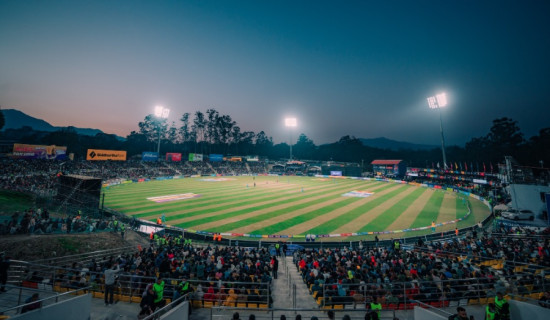- Monday, 15 December 2025
Glimpse Of Gorkhapatra’s Photographic Legacy
On 21st June 2024, I visited the photo exhibit at Gorkhapatra Sansthan with my friends from St. Mary’s School, Jawlakhel, accompanied by our teachers. The exhibition was launched on April 25, 2024, to note the National Photojournalism Day of Nepal and commemorate Gorkhapatra Sansthan's 124th birthday and Gorkhapatra Corporation’s fifty-second anniversary.
The title of the exhibition was “Looking Back at History,” which had a variety of pictures showcasing significant moments in Nepal’s past.
On reaching the Gorkhapatra Sansthan premises, we were greeted by Ram Humagai, the senior photographer there, who stated, "Photos are really important to mark the history of our country's gracious and tragic events."
He toured us around the exhibition and explained some of them. The pictures taken between 1973 and 2003 that are arranged for the display—we were shown a series of images by today’s standard when we entered the room. The first photo was taken by the newspaper’s initial edition, Gorkhapatra.
When I looked through these old photographs, the first thing that struck me was how far photography had come. It was an event that captured our thoughts and stretched our imaginations as we contemplated the progress of technology.
The photo exhibition was a tapestry of innovative pictures whisking one away through the decades—an intoxicating journey through Nepal's recent past. Right at the centre of the exhibition hall is this rickety wooden bridge that once connected Anamnagar and Thapa Gaun in New Baneshwor, before the construction of the sturdy concrete bridge with Japanese government aid. Further down, the harrowing remnants of a building destroyed by the earthquake in Dharan in 1988 were a sobering illustration of nature's powers, while the wacky image of a hippie strolling down the streets of the capital in 1976 captured a heady counterculture.
The exhibition also witnessed the democratic process, and views of the May 1991 elections were displayed alongside the poignant moment when King Birendra himself sightsees the historic Taumadi area of Bhaktapur during Queen Elizabeth II's visit to Nepal in 1985.The exhibition ran right up to the first SAARC summit in Dhaka, Bangladesh, a momentous day of diplomacy that sealed a historic milestone for regional cooperation. These evocative images were testimony to how Nepal also engages on the international scene in its efforts towards unity and progress for South Asia.
Deeper into the country's cultural heritage, the exhibition revealed candid photographs of locals during the production process of the Gorkhapatra and Rising Nepal newspapers in 1986. The images interrogate the role of media institutions in Nepal—one that is a little component of its daily running, underscoring their crucial contribution towards shaping public discourses on a maturing narrative.
Each photograph of this scintillating demonstration was a reminder of these epochal events or changes that have shaped and characterised the history of Nepal, inviting one to ponder over the incredible advance and resilience.
This photographic journey went through a large chunk of the country's political, diplomatic, and cultural legacy, filling new appreciation about the mosaic of experiences that have gone into the making of the Nepali identity over the decades.
We had the amazing chance to learn more about Nepal's extensive history in technology and journalism.
We were enthralled by a variety of intriguing antiques from the time we entered, including fax machines, printers, cameras, and other analogue marvels. Not only was it fascinating to view these old gadgets, but it was also instructive to see how they operated.
They were really amazing in the clever problem-solving and craftsmanship that went into their creation.
However, getting behind-the-scenes access to some of Nepal's leading journalistic organisations was the highlight of our trip. We were granted access to the offices of two of the nation's most esteemed print media establishments, Gorkhapatra and Muna.
The meeting with Bhimsen Thapaliya, an editor-in-chief of Rising Nepal, was the highlight. He kindly answered all of our inquiries and gave us priceless insider knowledge about the journalistic field.
We had the opportunity to see not just the editorial staff but also the inner workings of these news organizations.
We went to the print facilities where the newspapers were created and saw directly how carefully news was delivered to the public. We also saw how the organisations preserve their historical archives, with crews painstakingly repairing old photos and newspapers.
It was really encouraging to witness this meticulous endeavour to preserve Nepal's journalism heritage.
Grade: XII, St. Mary's School

















